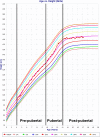Determination of Pubertal Status in Youths With Type 1 Diabetes Using Height Velocity and Trajectories
- PMID: 30346541
- PMCID: PMC6270965
- DOI: 10.1210/jc.2018-01737
Determination of Pubertal Status in Youths With Type 1 Diabetes Using Height Velocity and Trajectories
Abstract
Context: Assessment of pubertal change is important for the management of chronic pediatric diseases, such as type 1 diabetes. Physical and/or laboratory assessments of pubertal status are often unavailable, impractical, or costly.
Objective: To develop and validate a practical and objective method to assess pubertal status using longitudinal linear growth in youths with type 1 diabetes.
Design, participants, and outcome measurements: Participants (n = 123) were part of a 2-year study assessing continuous glucose monitoring in youths with type 1 diabetes at a tertiary diabetes center. Pubertal status at visits was assigned by a tiered approach using clinical Tanner staging or indicators of pubertal maturation from the electronic medical record when available. For other visits, independent evaluations of height velocities and growth chart trajectories provided data for pubertal status assignments. Sensitivity analysis confirmed the validity of the pubertal status assignments.
Results: The sample (50% female, 95% white) had a mean ± SD age of 12.7 ± 2.7 years, diabetes duration of 6.0 ± 3.6 years, and hemoglobin A1c of 7.9 ± 0.8%. Of 985 study visits, 50% received a pubertal status assignment based on clinical Tanner staging, 29% on additional medical record review, and 22% on an evaluation of height velocity and growth chart trajectory. For the sensitivity analysis, pubertal status assignments based on height velocity and growth chart trajectory matched clinical Tanner staging in 87% of visits.
Conclusions: Our practical and objective method to assess pubertal status based on height velocity and growth chart trajectory highlights growth as a reliable and objective bioassay for pubertal onset, status, and progression.
Figures


Similar articles
-
Pubertal growth, sexual maturation, and final height in children with IDDM. Effects of age at onset and metabolic control.Diabetes Care. 1997 May;20(5):721-4. doi: 10.2337/diacare.20.5.721. Diabetes Care. 1997. PMID: 9135933
-
Growth, puberty, and final height in children with Type 1 diabetes.J Diabetes Complications. 2006 Jul-Aug;20(4):252-6. doi: 10.1016/j.jdiacomp.2005.07.001. J Diabetes Complications. 2006. PMID: 16798477
-
Effect of glycemic control on growth velocity in children with IDDM.Diabetes Care. 1992 Jul;15(7):826-30. doi: 10.2337/diacare.15.7.826. Diabetes Care. 1992. PMID: 1516499
-
Pubertal growth assessment.Horm Res. 2003;60(Suppl 1):27-35. doi: 10.1159/000071223. Horm Res. 2003. PMID: 12955015 Review.
-
Methods for determining pubertal status in research studies: literature review and opinions of experts and adolescents.J Dev Orig Health Dis. 2020 Apr;11(2):168-187. doi: 10.1017/S2040174419000254. Epub 2019 Jun 17. J Dev Orig Health Dis. 2020. PMID: 31204632 Review.
Cited by
-
Distinct Patterns of Daily Glucose Variability by Pubertal Status in Youth With Type 1 Diabetes.Diabetes Care. 2020 Jan;43(1):22-28. doi: 10.2337/dc19-0083. Epub 2019 Jul 15. Diabetes Care. 2020. PMID: 31308020 Free PMC article.
-
Investigating the Incidence of Dyslipidemia among Brazilian Children and Adolescents Diagnosed with Type 1 Diabetes Mellitus: A Cross-Sectional Study.Diseases. 2024 Feb 24;12(3):45. doi: 10.3390/diseases12030045. Diseases. 2024. PMID: 38534969 Free PMC article.
-
Determining the timing of pubertal onset via a multicohort analysis of growth.PLoS One. 2021 Nov 18;16(11):e0260137. doi: 10.1371/journal.pone.0260137. eCollection 2021. PLoS One. 2021. PMID: 34793547 Free PMC article.
References
-
- Amiel SA, Sherwin RS, Simonson DC, Lauritano AA, Tamborlane WV. Impaired insulin action in puberty: contributing factor to poor glycemic control in adolescents with diabetes. N Engl J Med. 1986;315(4):215–219. - PubMed
-
- Swan KL, Weinzimer SA, Dziura JD, Steil GM, Voskanyan GR, Steffen AT, Martin ML, Tamborlane WV. Effect of puberty on the pharmacodynamic and pharmacokinetic properties of insulin pump therapy in youth with type 1 diabetes. Diabetes Care. 2008;31(1):44–46. - PubMed
-
- Szadkowska A, Pietrzak I, Mianowska B, Bodalska-Lipińska J, Keenan HA, Toporowska-Kowalska E, Młynarski W, Bodalski J. Insulin sensitivity in Type 1 diabetic children and adolescents. Diabet Med. 2008;25(3):282–288. - PubMed
-
- Cemeroglu AP, Thomas JP, Zande LT, Nguyen NT, Wood MA, Kleis L, Davis AT. Basal and bolus insulin requirements in children, adolescents, and young adults with type 1 diabetes mellitus on continuous subcutaneous insulin infusion (CSII): effects of age and puberty. Endocr Pract. 2013;19(5):805–811. - PubMed
-
- Danne T, Phillip M, Buckingham B, Jarosz-Chobot P, Saboo B, Urakami T, Battelino T, Hanas R, Codner E; ISPAD Clinical Practice Consensus Guidelines 2018 Compendium. Insulin treatment in children and adolescents with diabetes. Pediatr Diabetes. 2018;19:115–135. - PubMed
Publication types
MeSH terms
Substances
Grants and funding
LinkOut - more resources
Full Text Sources
Medical

